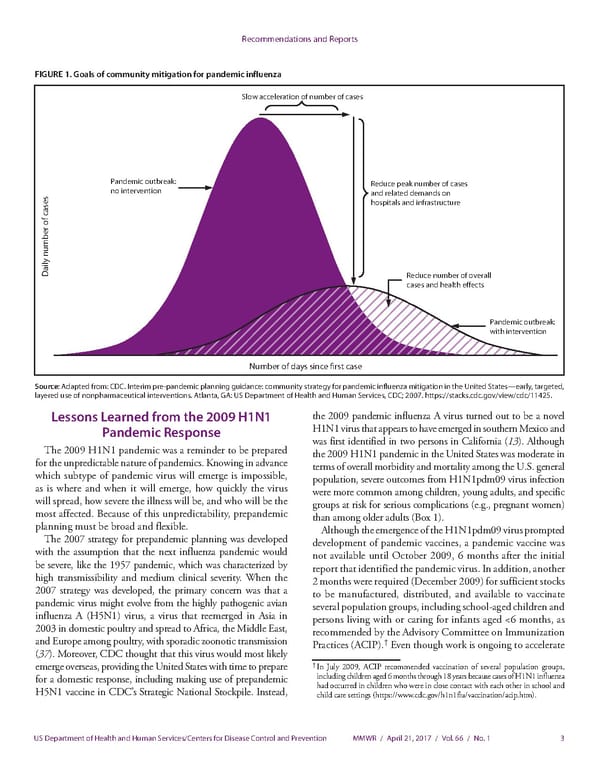Recommendations and Reports FIGURE 1. Goals of community mitigation for pandemic influenza Slow acceleration of number of cases Pandemic outbreak: Reduce peak number of cases no intervention and related demands on hospitals and infrastructure Daily number of cases Reduce number of overall cases and health effects Pandemic outbreak: with intervention Number of days since first case Source: Adapted from: CDC. Interim pre-pandemic planning guidance: community strategy for pandemic influenza mitigation in the United States—early, targeted, layered use of nonpharmaceutical interventions. Atlanta, GA: US Department of Health and Human Services, CDC; 2007. https://stacks.cdc.gov/view/cdc/11425. Lessons Learned from the 2009 H1N1 the 2009 pandemic influenza A virus turned out to be a novel Pandemic Response H1N1 virus that appears to have emerged in southern Mexico and was first identified in two persons in California (13). Although The 2009 H1N1 pandemic was a reminder to be prepared the 2009 H1N1 pandemic in the United States was moderate in for the unpredictable nature of pandemics. Knowing in advance terms of overall morbidity and mortality among the U.S. general which subtype of pandemic virus will emerge is impossible, population, severe outcomes from H1N1pdm09 virus infection as is where and when it will emerge, how quickly the virus were more common among children, young adults, and specific will spread, how severe the illness will be, and who will be the groups at risk for serious complications (e.g., pregnant women) most affected. Because of this unpredictability, prepandemic than among older adults (Box 1). planning must be broad and flexible. Although the emergence of the H1N1pdm09 virus prompted The 2007 strategy for prepandemic planning was developed development of pandemic vaccines, a pandemic vaccine was with the assumption that the next influenza pandemic would not available until October 2009, 6 months after the initial be severe, like the 1957 pandemic, which was characterized by report that identified the pandemic virus. In addition, another high transmissibility and medium clinical severity. When the 2 months were required (December 2009) for sufficient stocks 2007 strategy was developed, the primary concern was that a to be manufactured, distributed, and available to vaccinate pandemic virus might evolve from the highly pathogenic avian several population groups, including school-aged children and influenza A (H5N1) virus, a virus that reemerged in Asia in persons living with or caring for infants aged <6 months, as 2003 in domestic poultry and spread to Africa, the Middle East, recommended by the Advisory Committee on Immunization and Europe among poultry, with sporadic zoonotic transmission † Practices (ACIP). Even though work is ongoing to accelerate (37). Moreover, CDC thought that this virus would most likely † emerge overseas, providing the United States with time to prepare In July 2009, ACIP recommended vaccination of several population groups, for a domestic response, including making use of prepandemic including children aged 6 months through 18 years because cases of H1N1 influenza H5N1 vaccine in CDC’s Strategic National Stockpile. Instead, had occurred in children who were in close contact with each other in school and child care settings (https://www.cdc.gov/h1n1flu/vaccination/acip.htm). US Department of Health and Human Services/Centers for Disease Control and Prevention MMWR / April 21, 2017 / Vol. 66 / No. 1 3
 Community Mitigation Guidelines to Prevent Pandemic Influenza Page 4 Page 6
Community Mitigation Guidelines to Prevent Pandemic Influenza Page 4 Page 6